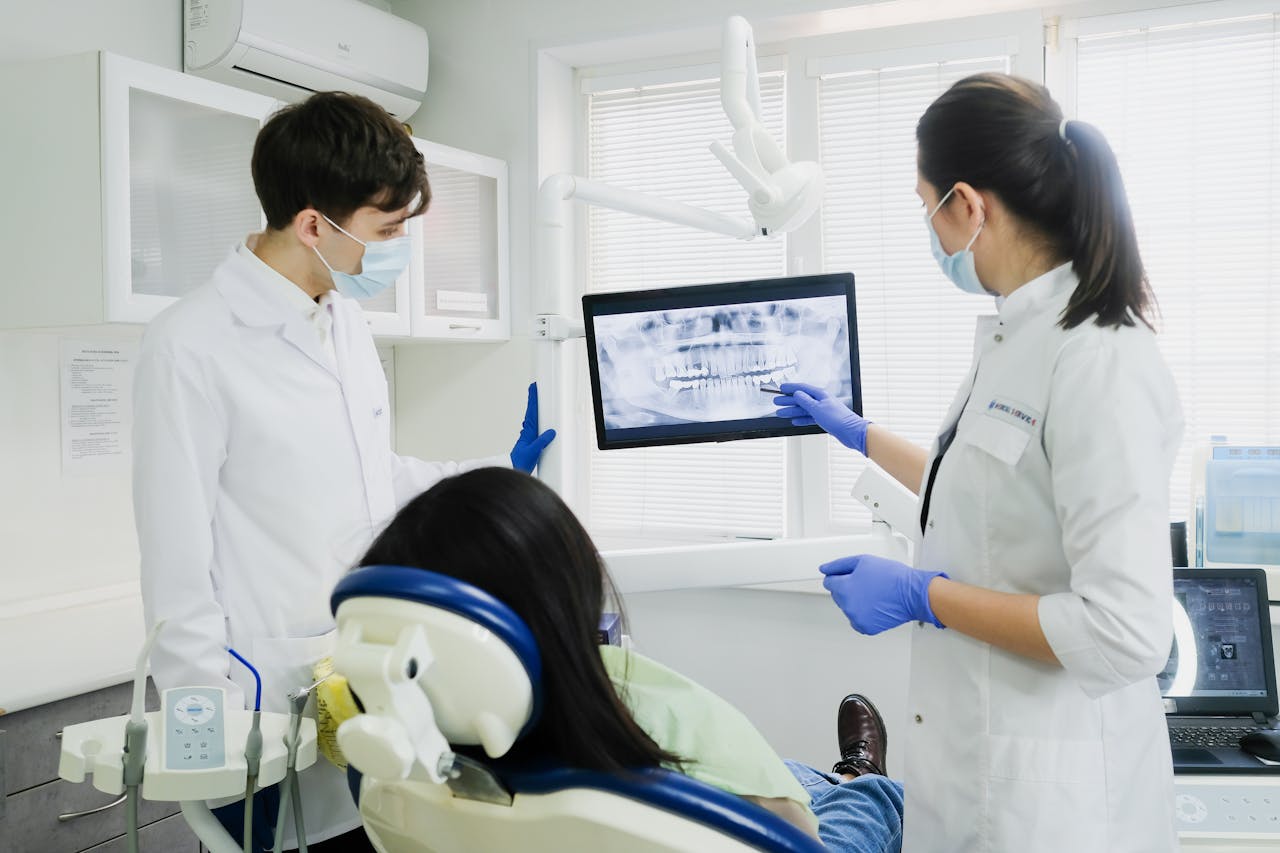56 Adaptive Learning AI in Healthcare Statistics for Dental Practices – Measurable ROI and Operational Gains in 2025

Comprehensive data compiled from extensive research across healthcare AI adoption, dental practice implementations, and patient communication systems
Key Takeaways
- Market momentum accelerates beyond projections - Healthcare AI market reaches $26.57-29.01 billion in 2024 with 37-39% CAGR, while 79% of healthcare organizations actively implement AI technologies
- Dental practices capture immediate returns - AI implementations deliver 24% revenue increases, time savings that translate to hours saved per clinician weekly, and positive ROI from day one with 6-month payback periods
- Communication systems eliminate traditional barriers - AI-powered systems achieve 90% reduction in missed calls and 56-72% reduction in no-show rates, directly addressing $150 billion industry problem
- Administrative efficiency delivers quantifiable savings - Healthcare organizations automate 45% of administrative tasks, saving $150 billion annually while boosting workforce productivity by 38%
- Compliance gaps threaten momentum - 67% of organizations remain unprepared for 2025 HIPAA AI standards, while only 24% of healthcare workers receive proper AI training
- Geographic and sector disparities emerge - Hospital AI adoption ranges from 48.94% in New Jersey to 0% in New Mexico, with DSOs leading dental implementations at scale
- Security challenges multiply with AI adoption - 13% of organizations report AI model breaches, with healthcare data breaches affecting 276.7 million records in 2024
- Investment validates technology confidence - Over $10 billion invested in AI healthcare companies in 2024, representing 30% of total healthcare funding
Market Adoption & Growth Metrics
- 79% of healthcare organizations actively use AI technology in 2024-2025, representing mainstream adoption across the industry. This figure from Microsoft-IDC research demonstrates that AI has moved from experimental to operational necessity. The rapid acceleration from pilot programs to production deployments reflects both competitive pressure and proven ROI metrics. Organizations not yet implementing AI risk a significant competitive disadvantage as the technology becomes standard practice.
- The healthcare AI market is valued at $26.57-29.01 billion in 2024, with projections reaching $110.61-187.69 billion by 2030. Grand View Research and Fortune Business Insights converge on these valuations, confirming extraordinary market expansion. The 37-39% compound annual growth rate significantly exceeds general healthcare IT growth. This explosive growth attracts both established technology companies and specialized healthcare AI startups competing for market share.
- Over $10.5 billion invested in AI healthcare companies in 2024, representing nearly 3x year-over-year growth according to PitchBook analysis. This investment surge accounts for 30% of total healthcare funding, demonstrating investor confidence in AI's transformative potential. The concentration of capital in AI-enabled companies signals a fundamental shift in healthcare technology priorities. First-half 2025 maintained momentum with $3.95 billion captured by AI companies.
- 18.7% of US hospitals have adopted AI, with striking geographic disparities revealed by Health Affairs Scholar. New Jersey leads with 48.94% adoption, followed by Utah at 41.38% and Connecticut at 35.00%, while New Mexico shows 0% and Mississippi lags at 1.85%. These disparities reflect differences in funding, infrastructure, and regulatory environments. Urban academic medical centers significantly outpace rural community hospitals in implementation rates.
- 66% of physicians used health AI in 2024, representing a 78% increase from 38% in 2023, according to American Medical Association surveys. This dramatic acceleration reflects growing confidence in AI tools for clinical decision support and administrative efficiency. Medical groups show similar adoption, with 43% adding or expanding AI use in 2024. Physician champions within organizations significantly accelerate peer adoption through demonstrated benefits.
- Voice AI healthcare market reaches $468 million in 2024, projected to hit $3.18 billion by 2030 at 37.79% CAGR per Grand View Research. Natural language processing capabilities enable conversational interfaces for patient engagement and clinical documentation. Voice-first interfaces reduce friction in healthcare workflows while improving accessibility. The technology particularly benefits elderly populations and those with disabilities requiring hands-free interaction.
- North America maintains a 54% global market share, with the US market specifically valued at $13.26 billion in 2024. Market analysis shows Europe follows with a 28% share, while Asia-Pacific rapidly expands at 41% CAGR. Regulatory frameworks, technology infrastructure, and healthcare spending patterns drive regional variations. China and India emerge as significant growth markets with government-backed AI healthcare initiatives.
- Widespread AI activity is reported across health systems, with approximately 80-86% reporting using some form of AI according to HIMSS/Medscape research, though ambient-scribe deployment specifically remains much lower at approximately 25-30% among medical groups. This exploration reflects recognition that the documentation burden represents a primary physician burnout. Early adopters of ambient scribes report a 50-70% reduction in documentation time. The technology's ability to capture natural clinical conversations transforms traditional workflows when implemented.
Dental Practice Implementation Results
- 18-35% of dental professionals have integrated AI into clinical workflows, with 60% currently using tools and 87% believing AI will become standard practice, according to HealthfulHelps analysis. This adoption rate exceeds many medical specialties, reflecting dentistry's imaging-centric nature and clear ROI pathways. Digital-native younger practitioners drive faster adoption rates than established practices. The visual nature of dental diagnostics creates ideal AI application opportunities.
- Dental AI imaging market reaches $417.5 million in 2024, projected to hit $3.83 billion by 2031 at 32.5% CAGR. Over $140 million in venture capital funded dental AI startups in 2024 alone. Market research confirms accelerating investment in diagnostic accuracy improvements. FDA clearances for dental AI applications continue expanding, validating clinical efficacy.
- 24% increase in restorative treatment plan value reported by practices implementing AI diagnostic tools. VideaHealth studies show improved pathology detection leads directly to increased case acceptance. AI-assisted diagnosis builds patient trust through visual evidence of treatment necessity. Practices report 13-21% improvements in overall case acceptance rates with AI support.
- Significant time savings are reported per clinician through AI diagnostic assistance and automated charting, with many organizations reporting hours saved per clinician per day or week, depending on the specific tools implemented. Per-visit savings vary by tool type, ranging from minutes per appointment for basic assistance to larger cumulative daily gains with comprehensive systems. Clinical efficiency gains translate directly to revenue opportunities and improved work-life balance. Hygienists complete 50% more perio charts using voice AI systems.
- Positive ROI achieved from day one with meaningful returns within 6 months for most dental AI implementations. Single practitioner practices achieve 16.48% ROI with 10+ month breakeven, while 5-practitioner practices reach 94.13% ROI with 6+ month breakeven. The rapid payback period reduces implementation risk and accelerates adoption decisions. Subscription-based pricing models eliminate large capital requirements.
- Heartland Dental completes the largest industry AI rollout across 1,700+ supported practices in 39 states, as confirmed by an official announcement. This enterprise-scale deployment demonstrates AI's readiness for multi-location standardization. Dental Care Alliance simultaneously deployed AI across 400+ affiliated practices. DSO adoption validates both scalability and measurable returns at enterprise levels.
- 8 out of 10 largest DSOs now use AI platforms, with DSO market share projected to grow from 23% in 2022 to 39% by 2026. Technology adoption represents a key DSO competitive advantage over independent practices. Centralized IT infrastructure enables faster, more cost-effective AI deployments. DSOs leverage AI for both clinical standardization and operational efficiency.
- 95% clinician adoption within 6 months of AI tool implementation in dental practices. This rapid uptake contrasts with typical healthcare technology adoption curves of 18-24 months. User-friendly interfaces and immediate clinical value drive voluntary adoption. Peer influence within practices accelerates technology acceptance.
Patient Communication Transformation
- 90% reduction in missed calls achieved by AI-powered communication systems across healthcare facilities. Industry studies demonstrate dramatic improvements from baseline 29% miss rates. Each missed call represents approximately $200 in lost revenue for appointment-related inquiries. AI systems ensure 24/7 availability without additional staffing costs.
- Intermountain Healthcare achieves an 85% reduction in call abandonment and 79% improvement in speed to answer across its 24-hospital, 385-clinic network per case study data. This enterprise deployment demonstrates scalability across complex health systems. Patient satisfaction scores increased 42-60% following AI voice solution implementation. The system handles over 1 million patient interactions monthly.
- 56-72% reduction in no-show rates using AI-powered reminder and scheduling systems. Randomized controlled trials with 42,000+ visits validate these improvements. No-shows cost the US healthcare system $150 billion annually, according to industry analysis. Automated reminders with two-way communication significantly outperform traditional one-way notifications.
- Healthcare practices typically miss 29% of incoming calls without AI assistance, with peaks reaching 40% during busy periods. Research confirms each missed call costs approximately $200 in lost appointment revenue. After-hours calls represent 27% of total inquiries, highlighting 24/7 availability. Small practices lose an estimated $96,900 annually from missed calls alone.
- 47% increase in digitally booked appointments at major medical centers implementing AI scheduling. The appointment scheduling software market reached $332.8 million in 2024, projected to hit $891 million by 2031. Patients cite convenience, speed, and 24/7 availability as primary digital booking drivers. Self-service options reduce staff workload while improving patient satisfaction.
- 81% of patients prefer human consultation for medical advice but show comfort with AI for administrative tasks: 60% for updating information, 56% for prescription refills, and 42% for routine scheduling. Interestingly, 67% feel more comfortable discussing sensitive health issues with AI chatbots than with human staff. Patients appreciate AI's non-judgmental (48%), unhurried (38%), and non-condescending (33%) interaction style.
- Patient satisfaction scores increase 42-60% with AI voice solutions implementation. Key drivers include reduced wait times, 24/7 availability, and consistent service quality. AI eliminates variability in staff mood or training levels. Multilingual capabilities expand access for diverse patient populations.
- 65% of patients would recommend providers offering superior digital experiences, including AI-powered communication. Digital experience increasingly influences provider selection decisions, particularly among younger demographics. Practices with poor digital presence lose patients to tech-enabled competitors. Online reviews frequently mention ease as a deciding factor.
Administrative Efficiency & Cost Savings
- $500 billion addressable administrative burden in US healthcare identified by the Center for American Progress. Administrative costs represent 30% of total healthcare spending, significantly higher than in other developed nations. AI automation targets the most repetitive and error-prone administrative processes. McKinsey estimates $265 billion in potential annual savings through comprehensive automation.
- Clinicians lose 28 hours weekly to administrative tasks, according to Google Cloud research. Nurses spend 25% of their work time on regulatory and administrative activities rather than patient care. This administrative burden contributes directly to the 43% physician burnout rate. AI documentation tools return 10+ hours weekly to clinical activities.
- 45% of administrative tasks are automatable with current AI technology, potentially saving $150 billion annually across the US healthcare system. Organizations implementing comprehensive AI report 38% workforce productivity boosts. Some departments achieve double employee productivity in specific functions like prior authorization. The compound effect of multiple AI tools creates exponential efficiency gains.
- The healthcare NLP market is valued at $4.9 billion in 2023, growing at a 34.7% CAGR to reach $37 billion by 2030, per Grand View Research. Clinical applications show NLP improving predictive accuracy from 0.831 to 0.922 AUC in ICU mortality models. Natural language processing enables unstructured data for clinical insights. Voice-to-text accuracy reaches 99.7% with medical vocabulary training.
- $20 billion potential annual savings from healthcare automation, according to the 2024 CAQH Index analysis. Electronic prior authorization alone could save $454 million annually. Automated eligibility verification eliminates 15 minutes per patient encounter. Claims processing automation reduces denial rates by 23%.
- Penn Medicine increases patient volumes by 25% using AI scheduling optimization. UCHealth achieved $8 million in value from 8% decrease in opportunity days. One organization recovered $1.14 million from AI-assisted coding error corrections. West Tennessee Healthcare added 61 surgical cases in the first 100 days, recovering 90% of the AI investment.
- 5-physician practice saves $291,200 annually using AI documentation tools, achieving 94.13% ROI. Single practitioners save $77,500 yearly with 16.48% ROI. Time savings compound with practice size due to shared infrastructure costs. Pricing varies widely across vendors - mainstream AI scribes range from approximately $99-600+ per provider per month, while enterprise-level deals and full ambient integrations can be significantly higher.
- 63% reduction in claims review times with AI-powered revenue cycle management. AI systems generated $2.394 billion in additional reimbursement across 1,000+ health systems in 2024. Denial rates decrease by 18% with AI-assisted coding accuracy. First-pass claim acceptance rates improve from 77% to 92%.
ROI & Revenue Impact
- 94-791% ROI documented for healthcare AI implementations within 6-18 months according to the Journal of the American College of Radiology. Radiology AI platforms demonstrate 451% ROI over 5 years, increasing to 791% when including radiologist time savings. These returns significantly exceed traditional healthcare IT investments. ROI accelerates as organizations optimize AI utilization post-implementation.
- 27% average revenue increases for practices implementing AI booking systems. Orthopedic service lines achieve 9% revenue growth within 100 days of implementation. Automated scheduling captures previously lost after-hours opportunities. Optimized appointment slots reduce gaps and improve provider utilization.
- $150 billion annual cost of no-shows addressed through AI intervention, achieving 56-72% reduction rates. Individual practices save $67,000-150,000 annually from reduced no-shows alone. Clinical studies validate these improvements across diverse patient populations. Two-way communication capabilities enable real-time rescheduling.
- Surgical scheduling AI achieves 4x ROI within 100 days at major health systems. Block time utilization improves from 68% to 89% with AI optimization. OR turnover time reduces by 23 minutes on average through predictive scheduling. Additional surgical volume generates $2.3 million quarterly revenue.
- Revenue cycle AI delivers $3.20 return per dollar invested with a 14-month average payback period per Microsoft-IDC analysis. Mid-sized facilities average $2.4 million in savings through comprehensive automation. Claims denial rates drop from 9% to 3.5% with AI assistance. Days in accounts receivable decreased by 6.8 days on average.
- AI-enabled practices demonstrate 27% higher revenue than traditional practices. These practices process patient interactions 50% faster while maintaining 24/7 availability. Comparative analysis shows technology adoption correlates strongly with practice growth rates. Patient acquisition costs decrease 34% through improved conversion rates.
- Dental practices report 10% revenue boosts from improved appointment efficiency alone. Case acceptance rates improve 13-21% with AI-supported treatment planning. Average treatment values increase by 24% through comprehensive diagnosis. Practices achieve a positive cash flow impact within 30 days of implementation.
- 35% cost reduction within 18 months for AI-enabled healthcare facilities. Labor costs decrease through automation while service levels improve. Overtime expenses drop 47% as AI handles after-hours inquiries. Technology ROI accelerates as staff proficiency increases.
Challenges & Implementation Barriers
- 67% of organizations remain unprepared for 2025 HIPAA AI standards, according to compliance analysis. New regulations require explicit AI governance frameworks and audit trails. Organizations struggle with rapidly evolving compliance requirements. Many lack dedicated AI governance committees or policies.
- Only 24% of healthcare workers receive AI training from employers despite 43% of medical groups expanding AI use. HIMSS research reveals this critical training gap undermines implementation success. Lack of training contributes to resistance and suboptimal utilization. Organizations with comprehensive training programs show 3x better AI adoption rates.
- 725 healthcare data breaches in 2024 affected 276.7 million records (81.4% of the US population) per HIPAA Journal. Healthcare maintains the highest breach costs at $9.77 million average, according to IBM Security. The sector remains the most expensive for data breaches for the 14th consecutive year. AI systems introduce new attack vectors requiring enhanced security measures.
- 13% of organizations reported AI model breaches in 2024-2025, with 97% of breached organizations lacking proper AI access controls per IBM research. Shadow AI usage caused breaches at one in five organizations. Encrypted AI implementations show 98% successful ransomware recovery rates. AI security requires specialized expertise beyond traditional IT security.
- 43% physician burnout rate persists despite the AI promise to reduce administrative burden. Physicians reporting enthusiasm exceeding concerns increased from 30% to 35% between 2023-2024. Those with concerns exceeding enthusiasm dropped from 29% to 25%. Change management remains critical for successful AI adoption.
- 61% of payers cite security concerns as the top barrier to AI scaling despite 340+ FDA-approved AI tools. Regulatory uncertainty slows enterprise adoption decisions. Insurance reimbursement for AI-enhanced services remains inconsistent. Payers worry about liability for AI-assisted clinical decisions.
- Medical coding accuracy remains challenging, with no large language model achieving above 50% exact match rate for ICD/CPT codes. GPT-4 leads at 49.5% for ICD-9 codes but struggles with complex cases. Human review remains essential for coding accuracy. Hybrid human-AI approaches show the best results.
- Integration complexity with legacy systems delays 67% of AI implementations beyond planned timelines. The average health system operates 18 different EHR systems requiring complex integration. API limitations in older systems prevent full AI capability utilization. Technical debt in healthcare IT infrastructure impedes AI adoption.
Future Outlook & Market Projections
- The healthcare AI market is projected to reach $110.61-187.69 billion by 2030 at a 37-39% CAGR according to leading market research firms. This growth rate exceeds broader healthcare IT market expansion by 3x. Investment continues accelerating with $10+ billion annual venture funding. Market consolidation expected as leaders emerge in specialized verticals.
- 85% of healthcare leaders are exploring generative AI capabilities for clinical and administrative applications. Generative AI promises to revolutionize medical documentation and patient communication. Early implementations show a 70% reduction in documentation time. Natural language interfaces democratize AI access for non-technical users.
- DSO dental market share growing from 23% to 39% by 2026, with technology adoption as a key differentiator. AI capabilities increasingly influence practice valuation multiples. Independent practices face pressure to adopt AI or join larger groups. Technology platforms become critical infrastructure for scaling dental organizations.
- Voice AI market reaching $3.18 billion by 2030, driven by natural language processing improvements and workflow integration. Ambient clinical documentation becomes standard in most clinical settings. Voice-first interfaces reduce training requirements and increase adoption. Multilingual capabilities expand healthcare access globally.
- 100% of health systems are expected to implement some form of AI by 2027 based on current adoption trajectories. Competitive pressure and proven ROI drive universal adoption. AI moves from differentiator to table stakes for healthcare delivery. Organizations without AI face obsolescence risk.
- Regulatory frameworks are evolving rapidly, with the FDA approving 50+ new AI applications annually. International standards for healthcare AI are emerging through WHO initiatives. Liability frameworks for AI-assisted decisions remain undefined. Ethical AI guidelines are becoming mandatory for healthcare implementations.
- Workforce transformation is accelerating with 2.7 million healthcare jobs requiring AI skills by 2030. New roles are emerging, including AI trainers, prompt engineers, and algorithm auditors. Traditional roles evolving to incorporate AI collaboration. Medical education curricula are adding mandatory AI components.
- Patient expectations are shifting permanently toward 24/7 digital access and AI-enhanced care delivery. Younger generations preferentially select AI-enabled providers. Patient-controlled AI health assistants are becoming mainstream. Continuous monitoring through wearables and AI is creating a predictive health paradigm.
Frequently Asked Questions
Q: What's the typical ROI timeline for dental practice AI implementation? Most dental practices achieve positive ROI from day one through immediate efficiency gains. Single practitioners typically see 16.48% ROI with 10+ month full payback, while 5-practitioner groups reach 94.13% ROI with 6+ month payback. The key is starting with high-impact applications like diagnostic AI or appointment scheduling that directly impact revenue.
Q: How significant is the missed call problem for healthcare practices? Healthcare practices miss an average of 29% of incoming calls, with each missed call representing approximately $200 in lost appointment revenue. Small practices alone lose an estimated $96,900 annually from missed calls. AI-powered communication systems achieve a 90% reduction in missed calls, essentially solving this longstanding industry challenge.
Q: Are healthcare organizations prepared for AI security requirements? No - 67% of healthcare organizations remain unprepared for stricter HIPAA AI standards coming in 2025. Additionally, 13% of organizations have already reported AI model breaches, with 97% of breached organizations lacking proper access controls. Organizations must prioritize AI governance frameworks and security measures immediately.
Q: What's driving the rapid physician adoption of AI? Physician AI adoption jumped from 38% to 66% between 2023-2024, driven by proven time savings (10+ hours weekly), improved diagnostic accuracy, and reduced documentation burden. Early adopter success stories and peer influence accelerate adoption within medical groups. The shift from skepticism to enthusiasm reflects real-world positive experiences.
Q: How does dental AI adoption compare to general healthcare? Dental practices show 18-35% AI adoption rates, with 60% of practitioners actively using AI tools. This matches or exceeds many medical specialties due to dentistry's imaging-centric nature and clear ROI pathways. Major DSOs lead adoption with implementations across thousands of locations, validating scalability.
Q: What administrative tasks benefit most from AI automation? Prior authorization, appointment scheduling, claims processing, and clinical documentation show the highest ROI from AI automation. Healthcare organizations can automate 45% of administrative tasks with current technology, saving $150 billion annually industry-wide. Documentation alone saves clinicians 10+ hours weekly.
Q: Why do some patients prefer AI for certain healthcare interactions? While 81% prefer humans for medical advice, 67% feel more comfortable discussing sensitive issues with AI. Patients cite AI's non-judgmental nature (48%), unlimited time (38%), and lack of condescension (33%) as key benefits. AI provides consistent, available service without the variability of human interaction.
Sources Used
- Grand View Research - AI Healthcare Market Analysis
- Fortune Business Insights - Healthcare AI Market Report
- American Medical Association - Physician AI Adoption Survey
- Health Affairs Scholar - Hospital AI Adoption Study
- HealthfulHelps - Dental AI Statistics 2024
- VideaHealth - Dental AI Implementation Studies
- Journal of American College of Radiology - Healthcare AI ROI Analysis
- HIPAA Journal - 2024 Healthcare Data Breach Report
- IBM Security - Cost of Data Breach Report 2024
- Center for American Progress - Healthcare Administrative Costs
- PubMed Central - AI No-Show Reduction Study
- HIMSS - Future of AI in Healthcare
- MarketsandMarkets - AI Healthcare Market Forecast
- PitchBook - Healthcare AI Investment Analysis
- Google Cloud Healthcare - Administrative Burden Research









